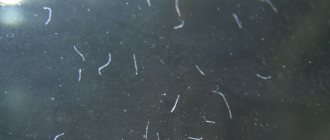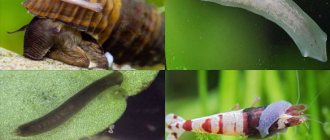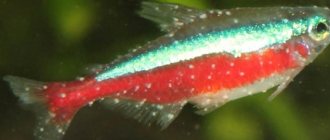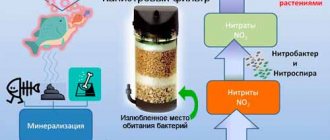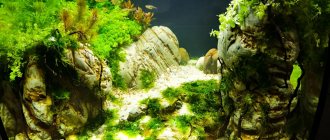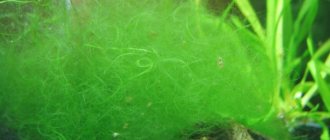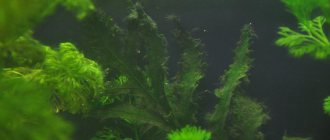Some plants appear unexpectedly in the aquarium and grow quite quickly. These types include filamentous. It gets its nutrition from compounds that are produced during photosynthesis. This is why thread reproduction occurs quickly. Just a few days are enough for the plant to fill the aquarium.
The filament may appear in the aquarium unexpectedly and grow quite quickly
Why does thread appear?
Filamentous algae are characterized by rapid reproduction rates. Under certain conditions, they can occupy the entire area of the aquarium. If filament appears in the aquarium, the reason for this may be an excess of any mineral substances in the water column. Other possible reasons:
- Intense lighting. Most often, filament appears in areas where there is access to direct sunlight or artificial lighting is used for more than 8 hours a day.
- Lack of oxygen.
- A small percentage of aquarium plants. Along with fertilizer, excess microelements enter the soil. If there is nothing to use it for, the thread quickly absorbs these substances.
- Rare water changes, insufficient purity. There is an accumulation of nitrates, requiring the development of filament.
Filamentous fish can often be found when aquarium fish are just starting to live in an artificial pond. This is explained by the fact that cultivated plants do not have time to get used to the environment, and therefore they do not receive microelements.
Sometimes filamentous algae enter the home along with plants purchased at a pet store.
Filamentum actively develops in hard water
Prevention
If you take preventive measures in a timely manner and monitor the balance, you can avoid the appearance of threads. Preventive measures:
- regular cleaning of the aquarium;
- regular water changes;
- suitable light: lighting should be turned off every day for 10-12 hours;
- preventing direct sunlight;
- planting other vegetation;
- installation of the filter and its regular cleaning.
Vegetation is necessary to maintain the natural balance of the environment, favorable for fish, but it should not be allowed to grow abundantly. It is necessary to regularly inspect and clean the aquarium and remove excess food. When filamentous algae appears, follow simple recommendations to prevent their spread, then no problems will appear in the aquarium.
Places of growth and external features
The plant feels good in water with increased hardness. Compared to other aquatic plants, filament has a salty taste. In some ways it resembles swamp mud. Such algae live in bodies of water with weak currents or standing water.
There are several signs by which you can determine whether a plant is a filamentous algae:
Green algae grow due to substances present in water. It also fuels their process of photosynthesis, which occurs in the light.
What soil to choose for an aquarium?
In order for the aquarium to become a comfortable home for its inhabitants and an excellent addition to the interior, you need to take into account some points when choosing soil.
Choosing the right soil for an aquarium
Table. Criteria for choosing soil for an aquarium.
| Name | Short description |
| Fraction size | If the inhabitants are small (small fish, mastocembelas, acatnophthalmus), and the plants have a fragile root system, then a shallow substrate is suitable. For large pets and plants with strong roots - large. |
| Faction form | The particles must be extremely smooth and even, without chips. This will reduce the risk of injury to fish and increase the survival rate of plants. |
| Inhabitants | If fish like to burrow into the ground or dig it (for example, loaches, corydoras, tarakatum, acanthophthalmus), then you need to use a shallow substrate. |
| Color | When choosing a shade, consider the overall style. You can use color rules or play with contrasts. |
The last selection criterion deserves more attention.
Potential danger
Filamentous algae are a collection of filaments of varying lengths. Sometimes they get tangled in bunches, become attached to the walls and clog the filter tubes. For this reason, the fight against filament in the aquarium should be timely. Most often they have a green tint, but sometimes there are varieties with black and brown colors.
The presence of a small amount of such algae is considered normal and indicates the presence of conditions suitable for reproduction in the aquarium. This means that higher plants will be able to fully develop here. On the other hand, when the number of filamentous growths exceeds all permissible limits, the release of toxic compounds is observed. They can negatively affect the inhabitants of the aquarium.
Algae retain organic matter and food residues on their surface. This causes water pollution. Small fish can also become entangled in these bundles. That is why it is necessary to fight them by all available means.
Introduction
The soil is one of the most important components in a planted aquarium. On one side, plant roots grow in it, on the other, plants receive nutrients from it. It should be noted here that plants partially obtain them from water (for example, K, Ca, Mg must be present in water). The presence of nutrients in the soil is especially important for plants with a developed root system - for example, cryptocoryne. If you grow elodea, then you don’t really need soil.
On the other hand, soil can act as a buffer for changes in water chemical parameters - for example, in an aquarium with African cichlids from Lake Malawi, soil containing a lot of limestone is usually used to maintain high water hardness.
A large number of materials are used as soil. Some of them will be discussed here and recommendations will be given for preparing soil for an aquarium. These recommendations are not the only correct ones - there are many paths leading to success and many aquarists follow their own rules.
The main question when choosing soil is what kind of aquarium you are going to use it for; For an aquarium with fish, where plastic or unpretentious plants such as Anubias grow. the choice of soil is not very important, since it serves mainly decorative purposes. Regular gravel will do the job.
If you are serious about growing aquarium plants and showing off your Dutch aquarium (or the Amano laurels are keeping you awake), then, along with lighting and a carbon dioxide installation, you will also have to think about the soil.
to the top of the page
Soil for an aquarium with fish
If you are not interested in growing plants (for example, you like plastic plants) or have unpretentious plants in your aquarium, such as elodea, then you can use pea gravel as soil. Particle sizes are about 3-5 mm. You can use decorative primer sold in an aquarium store. No need to use fine sand. It will quickly become clogged with dirt. especially when using a bottom filter. Make sure that the soil does not change the chemical parameters of the water - avoid marble chips and similar materials that will increase the pH value and hardness of the water. How to check the soil is written below.
Soil preparation is described in the corresponding section.
to the top of the page
Materials for preparing soil
There are many materials that can be used to prepare soil. They differ in their chemical and physical properties. Not all of them are necessary to successfully grow plants. Materials can be divided into basic (eg gravel, sand) and additives (eg peat). Additives are used to improve soil nutrition and are added to regular gravel. Some additives contain nutrients, some are used to retain these nutrients, preventing them from leaching into the water. This ability is called CEC (cation exchange capacity) - the material is able to retain positive ions (cations) of minerals - Fe, K, Zn, etc. Moreover, these substances are available to plants, which absorb them through the root system. Materials such as peat have a high CEC. Gravel and sand have almost zero CEC.
Gravel and sand
Fine gravel (2-5 mm in size) is usually the main component for preparing aquarium soil. It is not a source of nutrients for plants and does not have the ability to retain them (low CEC). It serves to anchor plant roots, as a top layer, on top of peat, etc. On the other hand, gravel allows nutrients from the water to penetrate inside, where they are absorbed by plant roots.
Fine sand is similar to gravel in that it does not contain nutrients and does not hold them well. It is usually used in a mixture with other components, such as peat, or as a top layer. Fine sand is not recommended when using a bottom filter, as it quickly becomes clogged with dirt and there is a danger of oxygen-free zones (some types of cryptocorynes are specially grown in fine sand).
Clay and laterite
Clay is a mixture of various inorganic materials - oxides and silicates of iron, aluminum, etc. - with very small particles (1-2 microns in size or less). Clay rich in iron is red in color. Some types of clay may also contain many other minerals - Mn, Zn, Cu, etc. Since plants need these minerals in small quantities, and in large quantities they can be toxic, such clay should be mixed with peat, humus, etc., which will retain these minerals in the form of organic complexes. Clay has a high CEC (it is able to retain nutrients well because it contains negative ions that attract positive ions of metals and salts).
Usually a small amount of clay is added to the soil - 10-15%, mixing it well with sand, gravel, etc. To facilitate mixing, the clay should be soaked until it becomes cloudy; you can also roll clay balls and add them to the bottom layer of soil. You can add fertilizer to these balls. If you use dry clay in powder form, wear a mask to prevent inhalation of this dust, which is harmful to the lungs. The suspended clay makes the water cloudy, so use clay only in the bottom layer of soil, especially if you have fish that like to pick at the soil or you frequently replant plants. You can use clay that is used for modeling, just make sure that it does not contain additives that make modeling easier - there are a lot of them used now.
Avoid using large amounts of clay containing aluminum with materials that have a low pH, especially peat, as toxic aluminum dissolves in water under these conditions. You can also add some limestone or dolomite to increase the pH.
Along with clay, laterite is also used in the aquarium - red soil from the tropics, which consists mainly of iron oxides. Laterite can be sold under various names - Duplarite, etc. Laterite is usually used as a base layer because it contains a lot of iron. It has a high (although lower than that of clay or peat) CEC
Instead of clay, you can sometimes use cat litter. The cheapest one is clay. Make sure that it does not contain any additives to absorb odor, etc.
garden soil
The soil that can be dug up in the garden is a mixture of clay, sand and organic components. humus, etc., which serve as a source of nutrients for plants. You should avoid using soil (especially mixed with manure or compost), which is sold in garden stores in large quantities. It contains too many nutrients, which will lead to high concentrations in the water - causing the growth of algae, as well as active decomposition processes in the soil, which you absolutely do not need. because first of all, oxygen is pumped out of the water, and if there is a lack of it, oxygen-free rotting begins. Land with a high organic content (for example, from a forest) has a fairly high CEC.
Sometimes a mixture of rotted leaves is added to the ground to grow cryptocorynes. Those interested can find the necessary information in the literature on their cultivation. For most plants this is not necessary.
Compost is almost entirely organic. It contains many nutrients, but it must be used in extremely small quantities or, best of all, not used. In addition to the release of nutrients into the water, when it decomposes, a large amount of ammonia, which is toxic to fish, is formed in the aquarium.
Earth. used for growing plants in pots, contains a lot of peat and organic matter. It can be used as an additive, similar to peat.
Peat
Peat is a mixture of partially rotted organic fossil materials. It is very rich in organic matter and humic acids. Peat releases less organic matter into the water than compost or soil. It has a high CEC value, retaining nutrients. Peat is used as a soil additive or as an intermediate layer. To prevent peat from clouding the water, use a layer of gravel or sand on top of it. Peat has the ability to soften water, reducing its hardness. Due to its increased acidity, peat helps create an increased concentration of plant-available iron in the soil.
to the top of the page
Using natural soil
Of course, you can buy special soil (especially gravel and beautiful pebbles) at an aquarium store. But this is usually expensive and not very suitable for a planted aquarium where special soil is needed. You can buy a bag of beautiful stones and then use it to decorate the aquarium - as a top layer.
On the other hand, you can dig up sand, gravel, soil somewhere in a ditch or buy it from a garden center. Natural soil differs from the soil sold in the store by much less organic matter. The organic matter in such soil is already rotted, which will reduce the decomposition time of the soil when starting the aquarium. Typically, soil from a garden store is used only in small quantities, as an additive to gravel or sand. Avoid soil to which organic fertilizers have already been added - nitrates, phosphates, etc. This will cause algae to grow in the aquarium,
Collect soil in places where water does not stagnate - this will reduce the amount of salts in the soil you collect, including any metal compounds. Therefore, there is no need to dig gravel near the sewer.
If you collect gravel from a natural reservoir, then disinfect it - it may contain algae spores, bacteria, etc. You can use bleach for this.
to the top of the page
Preparation and use of soil in the aquarium
The use of land, including when mixed with peat, is the subject of endless debate. For some, nothing works out and the plants grow worse than when grown in plain gravel. For some, it turns out the other way around. A properly prepared mixture of soil and peat allows you to more successfully grow plants with a developed root system, for example cryptocorynes, which have a branched root system (pull a large cryptocoryne bush out of the soil and look at its roots). Plants that have white roots, indicating the presence of a large number of air channels, grow better in such soil because they can provide air flow into the soil. On the other hand, plants such as Anubias, Aponogentons, etc. They feel worse in soil where air exchange is insufficient.
The main mistake that is made when using soil is that it is used soil that is too rich in organic matter, for example, from a garden store or compost. Soil excavated from the forest does not have as much organic matter, so it can be used directly.
The same applies to peat (or a mixture of soil and peat, which usually contains less organic matter than soil from a store). It is necessary to prepare a mixture of earth and water, in which it is something like a thick soup. The mixture is then strained through a mesh, such as a fly screen. The gauze has too small holes; an aquarium net is quite suitable for this purpose. At the same time, roots, stones and other pure organic matter are filtered out. This filtered soup can be used to prepare the middle layer of soil. After filtering, it can be dried or directly used. by squeezing the water out of it, for example, through gauze. If you carefully place a top layer of sand or gravel on top, the earth will not muddy the water.
The decomposition of the land will proceed especially quickly in the first few weeks. Therefore, do not rush to add fish to such an aquarium. Use a few cheap fish (zebrafish, mollies) to start the nitrate cycle in your aquarium. During the first few weeks, a lot of nitrates and phosphates will be released, especially in soil rich in organic matter, which can lead to algae growth. One way to avoid this is to pre-soak the soil for three to four weeks and then rinse it. The peat used will initially release a lot of humic acids, which lower the pH value of the water and color it yellowish. You should change a large amount of water quite often - up to 80-90%. You can also soak the peat in advance. All these factors lead to the fact that the launch of such an aquarium takes much longer than the launch of a regular aquarium.
If you are using heating cables in the ground, it is especially important that the soil is not nutrient dense or contains a large amount of organic matter, such as peat. Decomposition will proceed too quickly when the soil heats up. You don't need too much of a good thing. If you do not have experience in using earth, then it is better to refrain from using it with cables
to the top of the page
How to check that the soil does not increase water hardness
If you are preparing soil for an aquarium with soft water, then you better check in advance that the soil does not increase the pH and hardness of the water. Otherwise, it will be almost impossible for you to reduce the pH value. This is especially important if you are digging from a nearby ditch or buying from a dubious location.
The easiest way is to pour the soil into a glass with acetic acid. If you see gas bubbles, this means that the acid is reacting with the soil, releasing carbon dioxide, i.e. the soil contains carbonates and bicarbonates (for example, limestone), which you do not need at all. On the other hand, if you are keeping African cichlids that live in hard water, then you may want to add a material that will have a buffering capacity to keep the pH value high.
to the top of the page
Laying soil in an aquarium
Here we describe one of the possible schemes for laying soil in an aquarium with plants. This scheme is not the only correct one (as usual, there are many paths to success), but it is simple and, if other conditions are met - fertilizing, proper lighting, using CO2 and, of course, following the recommendations described below, it allows you to achieve success. Failure to meet one of the conditions (lighting, CO2, etc.) can ruin all your efforts to grow a green forest in an aquarium. The success of this method has been confirmed both by my practice and by many others. If the main fish in the aquarium are fish, and plants play a secondary role, then you don’t need to do all this - you can just use gravel.
It is suggested that you do not use a bottom filter, which is not recommended for use in a planted aquarium as it will leach nutrients from the substrate into the water where they will be available to algae. On the other hand, using fine soil will quickly clog the filter. An option for using such a filter in an aquarium with plants is described below.
The soil is laid in three layers:
- The bottom layer consists of iron-rich laterite or clay-enriched gravel (you can, for example, use a mixture of gravel and cat litter - make sure that it does not contain additives to eliminate odor, etc.). The thickness of the layer is 3-5 cm. It is good to add clay balls with fertilizers to this layer. You can add a little mixture of trace elements (not containing nitrates and phosphates) - about 1 g per square meter of aquarium area. It is desirable that the mixture contains more iron, which must be in chelated form, otherwise it will not be available to plants. There is no need to use iron sulfate, which is widely used when feeding garden bushes - sulfates will reduce the acidity of the water. All this will provide nutrition to the roots of the plants. If you use heating cables, they must be laid in the bottom layer. Heating cables should not lie directly on the bottom - uneven heating of the glass can lead to cracking - use stands. Do not place fine sand or clay if you are using heating cables - this may lead to uneven overheating of the soil, etc. Be sure to read about the use of earth in conjunction with heating cables above
- The middle layer contains soil with the addition of peat (15-25% by volume). Above it is written about what kind of land can be used. The thickness of the layer is 2-3 cm (no thicker - this can lead to rotting of the soil). If the soil contains a large amount of organic matter, then it should be mixed with sand. You can add trace elements and clay balls to this layer. Be sure to properly prepare the peat and soil, as described above. It also describes the pros and cons of using such a layer in an aquarium.
- The top layer is 3-5 cm of ordinary fine gravel, mixed with sand. This layer serves to prevent peat and soil from clouding the water. Here you can use any beautiful stones that you liked in the store.
If you keep fish or snails that like to dig in the ground, such as cichlids. then this method of laying soil is unlikely to suit you. In this case, you will either need to increase the thickness of the top layer or grow the plants in pots.
to the top of the page
Using a bottom filter in a planted aquarium
Bottom filter (UGF, RUGF) is widely used in fish aquariums. There is constant, ongoing debate about its use in a planted aquarium. For some, everything grows well even when using a bottom filter, for others nothing works. Of course, in addition to the presence or absence of a bottom filter in an aquarium, there are many other factors that affect plant growth. However, it can be said that the disadvantage of using such a filter (in addition to the other disadvantages that any filter has) is that nutrients from the soil are washed into the water, where they become food for algae. In a planted aquarium this is more critical. My practice has shown that using a bottom filter will not lead to better or worse plant growth, provided other conditions are met (light, fertilizer, etc.). It will make the system more unstable, i.e. if you neglected to do something, algae will appear faster than in an aquarium without such a filter. Usually it is necessary to increase the thickness of the soil (the bottom layer, when laying the soil in layers). You also need to make sure that the gravel does not fall through the filter board, for example, put a mesh. Unfortunately. this leads to a decrease in the efficiency of the filter.
You can refuse to use the bottom filter in its original form and use it in a slightly modified form. A board from the bottom filter and two tubes are used. In one, the water rises using a pump. The other is open; you just need to install a net with large holes to prevent fish from swimming in. Water is sucked under the board through this tube. In this scheme, there is practically no pumping of water through the ground (in a long aquarium, you can make several intake tubes).
You should not place a sponge or filter on the intake pipe, because as the water becomes dirty, the flow of water through this hole will be limited, which will cause water to be pumped through the ground.
This scheme does not have the disadvantages of a bottom filter. True, it does not filter. Its advantages include:
- The lower layer of water is saturated with oxygen, which reduces the likelihood of the formation of oxygen-free areas in the soil.
- Warm water from the aquarium flows down. This leads to a more uniform temperature in the soil. Many plants like to keep their feet warm. You can additionally install a weak heating pad (5-10 W) to heat the water. A stronger heater will create a counterflow of water in the intake tube.
- The collection tube can be injected with CO2 if you are using it. At the same time, you can see how the bubble tries to rise in the downward flow of water and dissolves quite quickly. However, later I abandoned this method for fear of creating water with a low pH under the ground by dissolving CO2.
- In the initial period, you can close the intake pipe and pump water through the ground. This will lead to faster decomposition of peat and soil during the initial period of starting the aquarium.
It should be noted that such a system must be cleaned, since after some time it will begin to become overgrown with dirt and bacteria under the filter board. This can be done using a brush on a long wire, which is inserted into the intake tube. You can also insert a hose into which you can run tap water, and pump water from the second tube out of the aquarium. The hose should be run under the filter plate for better dirt removal. Therefore, do not place mesh at the bottom of the tubes that are usually included with such filters - it will interfere with cleaning.
to the top of the page
Algae control methods
The first thing to be wary of is excess phosphorus and nitrogen. The lighting intensity should be worked out and the filter functions adjusted. Algae growth is favored by blue light. It should be replaced with a softer one. When the filter is clogged, ammonia accumulates. The same thing happens when there are a minimum of plants in the aquarium, and there are a large number of fish. Filamentous algae are inhibited by floating plants and those that grow quite quickly. They take away nutrition from the filament.
You should pay attention to excess iron in aquarium water. The maximum permissible concentration is 0.2 mg/l. When settling with Spirogyra, you can remove the algae manually. This is practically the only effective way to get rid of filament in an aquarium. Plants should be promptly cleared of threads and washed.
CO2 supply is allowed during the day. During cleaning activities, it is recommended to darken the aquarium for 3 days. Sometimes algaecides demonstrate high effectiveness. An example is the drug Sidex. Algae do not like hydrogen peroxide. It is necessary to use this composition in an amount of 6-10 mg per liter to effectively combat filament in the aquarium.
Do not ignore environmental methods for destroying algae. For example, you can release various parasites into a pond:
To get rid of threads you need to adjust the filter
Laying rules
Starting an aquarium on nutrient soil prepared by the owner himself begins with disinfection of the substrate.
All solid components are washed with running water , then immersed in a solution of potassium permanganate for half an hour.
Wash again under water to remove residual potassium permanganate. The last step is to add water and boil for 45 minutes.
Eventually
- the first layer is medium-grained sand, it is poured directly onto the bottom of the aquarium;
- 2nd - adsorbent (coal);
- 3rd - nutrient support;
- 4th - the final layer of coarse sand, small pebbles or rounded crushed stone.
Usually the soil is distributed evenly over the entire bottom area. Some aquarists make artificial elevations to the back wall, creating the effect of a distant picture.
Then the pond is decorated: plants are planted, decorations are installed and equipment is placed.
What color should aquarium soil be?
Aquarium substrates are available in a wide range of colors. But this does not mean that you can buy the first one you come across. Indeed, for some fish, dark pebbles are not suitable from an aesthetic point of view; for others, a light bottom in combination with bright light provokes stress.
The color of the soil can be any
On a note ! Bright fish look best against a black substrate, goldfish look best against a white substrate, although dirt will be more noticeable on such a substrate. To create an unusual landscape, a multi-colored “Caramel” mixture, glass pebbles or other mixtures intended for decorating the aquarium bottom are often used.
What cannot be used as aquarium soil?
Remember the main thing: you cannot put anything in the aquarium that is not intended for it! There is often advice on the Internet regarding cat litter , but such material can simply kill fish. There are also materials when using which you need to be extremely careful.
Cat litter should not be used
For example, glass primer is neutral and aesthetically pleasing, but lacks porosity. But beneficial bacteria, as noted earlier, multiply precisely thanks to the porous bottom. A smooth surface does not retain the nutrients needed by plants. In a word, if you want to decorate the bottom of the aquarium with arrowheads, vallisneria or other vegetation, choose a different bedding, since they will not take root in glass.
Important ! To combine plants and glass soil, beginners sometimes lay it in layers. Forgetting that any aquarium soil must breathe! Due to layering, the soil loses its porosity, and without proper care this will lead to rotting of the root system, stagnation, and waterlogging.
Choosing aquarium soil
Garden soil of any acidity is not suitable for an aquarium The water in it will begin to oxidize, which will provoke decay and, possibly, the death of all inhabitants - both plants and fish.
Reproduction
Dwarf crayfish live a short life - no more than 2 years, so it is important for them to regularly produce offspring (up to 4 times a year). When breeding for one male, two or three females should be provided.
After the molting period, mating begins, which begins with a ritual dance with the connection of the antennae. After three weeks, the female produces clusters of eggs. Young individuals can have 10-15 of them, adults - up to 50. At this time, the female tries not to leave the shelter. Therefore, you should try to throw food as close to the shelter as possible.
After hatching, the crustaceans do not leave their mother and constantly follow her. Only after the first molt do the juveniles begin to look for food on their own. If crayfish are kept in the same aquarium with fish, then it is better to place the female with eggs in a spawning tank, since the young have no chance of surviving - the fish will eat it. In the species reservoir, nothing threatens them, but their parents do not show any concern for them.
Bryozoans
We can say that this is a freshwater coral, unfortunately, it is quite small and short-lived. The size of an individual individual, a zoid, is small and amounts to only a few millimeters. But they form colonies that grow up to several centimeters.
Colonies of bryozoans look like corals. They feed on small particles of phyto and zooplankton. With fan-like tentacles, bryozoans direct a stream of water with plankton into the oral cavity. Thanks to the filtering method of feeding, bryozoans are considered useful for the aquarium, as participants in water purification.

